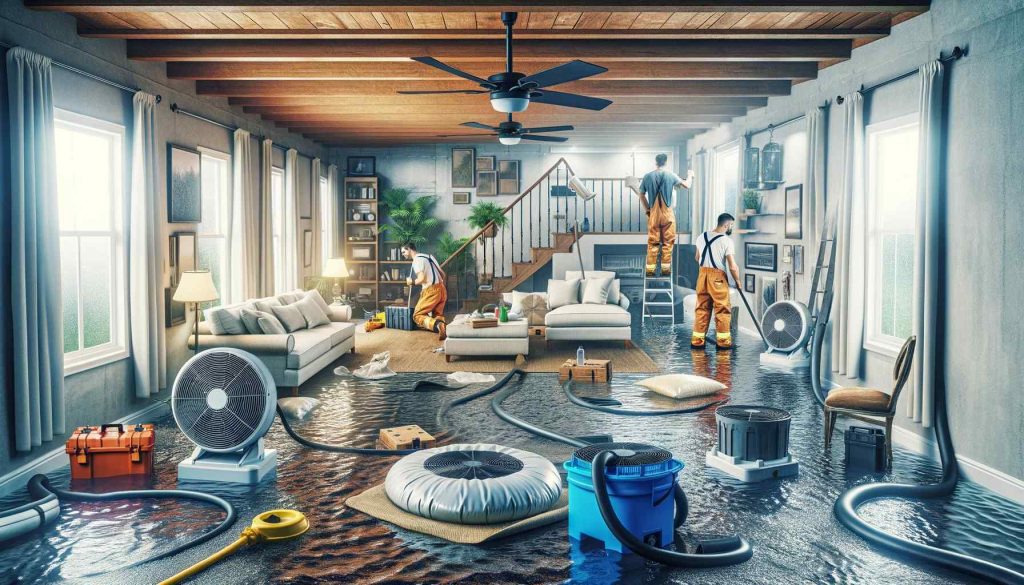Water damage can strike at any time, wreaking havoc on our homes and businesses. From burst pipes to flooding caused by natural disasters, the effects of water damage can be devastating. That’s why understanding water mitigation is crucial for both residential and commercial property owners. In this comprehensive guide, we will unlock the secrets of water mitigation, providing you with the knowledge and tools to protect your property and mitigate the damage caused by water.So what exactly is water mitigation? It goes beyond simply removing the water from an affected area. Water mitigation involves a systematic approach that aims to minimize the impact of water damage and restore the property to its pre-loss condition. It is a multifaceted process that requires a deep understanding of water behavior, structural drying techniques, and the use of specialized equipment.Throughout this guide, we will delve into the intricate details of water mitigation, exploring the different methods and strategies used to effectively address water damage. Whether you’re a homeowner dealing with a flooded basement or a business owner faced with the aftermath of a pipe burst, this guide will provide you with the knowledge and insights needed to tackle the situation head-on.Join us as we unravel the mysteries of water mitigation and empower ourselves with the tools to protect our valuable assets. Understanding water mitigation is not only essential for dealing with water damage emergencies but also for preventing future incidents. So let’s dive in and discover the secrets that will help us safeguard our properties and ensure their longevity.
The Importance of Water Mitigation: Protecting Your Property from Devastating Water Damage
Water damage can have catastrophic consequences for your property. From structural damage to mold growth, the effects of water damage can be long-lasting and expensive to repair. That’s why water mitigation is so important. By taking immediate action and implementing effective mitigation strategies, you can minimize the impact of water damage and protect your property from further destruction.
Water mitigation involves a series of steps that are designed to remove excess water, dry out the affected areas, and restore the property to its pre-loss condition. It goes beyond simply removing the visible water; it also addresses hidden moisture that can lead to mold growth and other issues.
When it comes to water mitigation, time is of the essence. The longer water sits in your property, the more damage it can cause. That’s why it’s crucial to act quickly and enlist the help of professionals who specialize in water mitigation.


Understanding Water Mitigation: Beyond Simple Water Removal
Water mitigation is not just about removing standing water from your property. It involves a comprehensive approach that includes assessing the extent of the damage, drying out affected areas, and restoring your property to its pre-loss condition.
The first step in water mitigation is assessing the extent of the damage. This involves determining how much water has entered your property and identifying any areas that are particularly vulnerable to further damage.
Once the assessment is complete, the next step is removing excess water from your property. This may involve using pumps or other specialized equipment to extract standing water from floors, carpets, or other surfaces.
After the excess water has been removed, it’s time to start drying out the affected areas. This may involve using industrial-grade dehumidifiers and fans to circulate air and remove moisture from the air and surfaces.
Throughout the drying process, it’s important to monitor the moisture levels in your property to ensure that all affected areas are thoroughly dried. This may involve using moisture meters or other specialized equipment.
Water Behavior: How Water Moves and Spreads during Damage
In order to effectively mitigate water damage, it’s important to understand how water behaves and spreads during an incident. Water can move quickly and easily penetrate porous materials, such as drywall, wood, and carpet.
When water enters a property, it can spread horizontally and vertically through walls, floors, and ceilings. It can also seep into hidden spaces, such as crawl spaces or behind cabinets.
Understanding how water moves and spreads is crucial for identifying all affected areas and ensuring that they are properly dried out. It also helps in preventing further damage by addressing any potential sources of water intrusion.
Assessing the Extent of Water Damage: Determining the Severity of the Situation
Assessing the extent of water damage is a critical step in the mitigation process. It helps determine the severity of the situation and guides the restoration efforts.
During the assessment, professionals will evaluate both visible damage and hidden moisture. They will use specialized equipment to detect moisture levels in walls, floors, and other structural components.
The severity of water damage is typically classified into different categories based on the amount of water involved:
- Category 1: Clean Water – This refers to water that comes from a clean source, such as a broken pipe or faucet leak. It poses no immediate health risks.
- Category 2: Gray Water – This refers to slightly contaminated water that may contain chemicals or microorganisms. It can cause discomfort or illness if ingested.
- Category 3: Black Water – This refers to highly contaminated water that may contain sewage, chemicals, or other hazardous substances. It poses significant health risks and requires professional handling.
By assessing the extent of water damage and classifying it into the appropriate category, professionals can determine the best course of action for mitigation and restoration.
The Water Mitigation Process: A Step-by-Step Guide to Minimizing Damage
The water mitigation process involves several steps that are designed to minimize damage and restore your property to its pre-loss condition. Let’s take a closer look at each step:
1. Emergency Response: When water damage occurs, it’s important to act quickly. Contacting a professional water mitigation company is crucial for immediate response and assessment of the situation.
2. Assessment: Professionals will assess the extent of the damage and develop a mitigation plan tailored to your specific situation.
3. Water Removal: Excess water is removed from your property using pumps or other specialized equipment.
4. Drying: Industrial-grade dehumidifiers and fans are used to dry out affected areas, preventing further damage and mold growth.
5. Cleaning and Sanitizing: All affected surfaces are thoroughly cleaned and sanitized to prevent bacterial or mold growth.
6. Restoration: Once your property is dry and clean, restoration work begins. This may involve repairing damaged structures, replacing flooring or carpets, or repainting walls.
Structural Drying Techniques: Restoring the Property to Its Pre-Loss Condition
In order to effectively mitigate water damage, it’s important to employ proper structural drying techniques. These techniques help restore your property to its pre-loss condition and prevent further damage.
Structural drying involves removing excess moisture from building materials, such as drywall, wood, and concrete. This is done using specialized equipment, such as dehumidifiers and air movers.
The goal of structural drying is to reduce the moisture content in affected materials to an acceptable level. This helps prevent mold growth, warping of wood, and other issues that can arise from prolonged exposure to moisture.
During the structural drying process, professionals will monitor the moisture levels in your property using moisture meters or other specialized equipment. This ensures that all affected areas are thoroughly dried out before restoration work begins.
Specialized Equipment: Tools for Effective Water Mitigation
Water mitigation requires the use of specialized equipment to effectively remove excess water and dry out affected areas. Here are some of the most commonly used tools:
- Pumps: Pumps are used to remove standing water from floors, carpets, or other surfaces.
- Dehumidifiers: Dehumidifiers help remove excess moisture from the air and surfaces, preventing further damage and mold growth.
- Air Movers: Air movers circulate air and promote evaporation, aiding in the drying process.
- Infrared Cameras: Infrared cameras are used to detect hidden moisture in walls, floors, and ceilings.
- Moisture Meters: Moisture meters measure the moisture content in building materials, helping professionals determine if an area is properly dried out.
The use of specialized equipment ensures that water mitigation efforts are effective and thorough. It allows professionals to accurately assess the extent of the damage and monitor the drying process.
Common Challenges in Water Mitigation: Overcoming Obstacles for Successful Restoration
Water mitigation can be a complex process, and there are often challenges that need to be overcome for successful restoration. Here are some common challenges:
- Hidden Moisture: Water can seep into hidden spaces, such as behind walls or under flooring. Detecting and removing hidden moisture is crucial for preventing further damage.
- Mold Growth: If water damage is not addressed promptly and effectively, it can lead to mold growth. Mold can cause health issues and further damage to your property.
- Structural Damage: Water can weaken structural components, such as wood or drywall. Repairing or replacing damaged structures may be necessary during the restoration process.
- Insurance Claims: Dealing with insurance companies can be challenging. It’s important to document all damage and work closely with your insurance provider throughout the mitigation and restoration process.
By understanding these common challenges and working with experienced professionals, you can overcome obstacles and ensure successful water mitigation and restoration.
Preventive Measures: How to Avoid Water Damage in the Future
The best way to deal with water damage is to prevent it from happening in the first place. Here are some preventive measures you can take:
- Maintain Your Property: Regularly inspect your property for any signs of leaks or water damage. Address any issues promptly before they escalate.
- Proper Drainage: Ensure that your property has proper drainage systems in place to redirect water away from your foundation.
- Insulate Pipes: Insulate exposed pipes to prevent them from freezing and bursting during cold weather.
- Install a Sump Pump: A sump pump can help prevent basement flooding by removing excess water.
- Monitor Humidity Levels: Use a dehumidifier to maintain optimal humidity levels in your property, especially in areas prone to moisture buildup.
By taking these preventive measures, you can reduce the risk of water damage and protect your property from costly repairs and restoration.
Conclusion: Empowering Yourself with Knowledge and Tools for Effective Water Mitigation
In conclusion, water mitigation is a crucial process that helps protect your property from devastating water damage. By understanding the intricacies of water behavior, employing effective drying techniques, and using specialized equipment, you can minimize the impact of water damage and restore your property to its pre-loss condition.
Throughout this comprehensive guide, we have explored the importance of water mitigation and provided insights into the different aspects of the process. From assessing the extent of water damage to implementing preventive measures, we have covered it all.
By empowering yourself with knowledge and tools for effective water mitigation, you can safeguard your valuable assets and ensure their longevity. Remember, time is of the essence when it comes to dealing with water damage. Act quickly, enlist professional help and take preventive measures to protect your property from future incidents. Here at American Restoration we specialize in Water Damage Restoration and can help you!
Understanding water mitigation is not only essential for dealing with emergencies but also for maintaining a safe and healthy living or working environment. So take action today and unlock the secrets of water mitigation!


